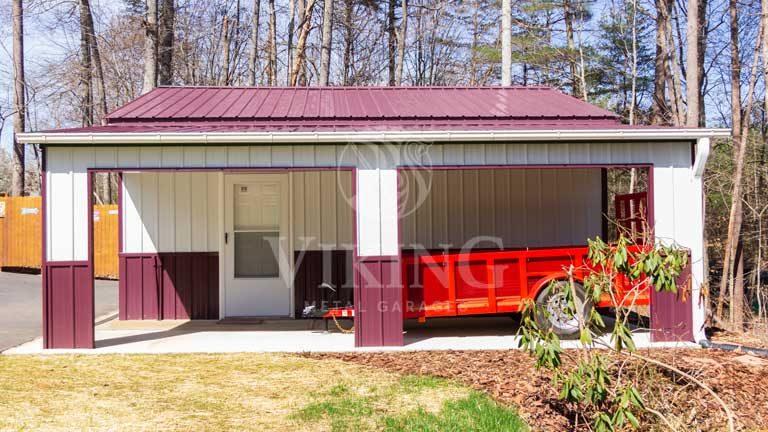How to Transform Your Backyard Metal Shed into the Perfect Yoga Retreat?

Have you ever walked past that metal shed in your backyard and wondered if it could be something more than just storage for garden tools and holiday decorations? What if I told you that humble structure could become your personal yoga sanctuary – a peaceful retreat where you can practice, meditate, and reconnect with yourself without ever leaving your property?
Converting a metal shed into a yoga studio isn't just a trendy DIY project; it's a practical solution for creating dedicated wellness space in our increasingly busy world. With the rising costs of gym memberships and studio classes, plus the convenience of practicing on your own schedule, a backyard yoga studio offers both financial and lifestyle benefits that extend far beyond the initial investment.
Why Metal Sheds Make Excellent Yoga Studios?
Before we dive into the transformation process, let's talk about why metal buildings are particularly well-suited for this conversion. Unlike wooden structures that can warp, rot, or attract pests, metal sheds offer durability and low maintenance – two qualities every yoga practitioner can appreciate. They're naturally weather-resistant, fire-resistant, and provide excellent structural integrity for years of peaceful practice.
Metal buildings also offer superior customization options. Their clear-span design means fewer interior support beams interrupting your flow, giving you maximum usable space for movement. Plus, metal conducts temperature efficiently, making it easier to maintain comfortable conditions year-round with proper insulation and climate control.
Planning Your Yoga Studio Conversion
Assessing Your Current Structure
Start by evaluating your existing shed's condition and dimensions. Most standard backyard sheds range from 10x12 feet to 12x20 feet – perfect for personal yoga practice or small group sessions. Check for any structural issues, rust spots, or areas needing repair before beginning your conversion.
Consider the shed's current placement in your yard. Ideally, your yoga studio should face east to catch the morning sun, be positioned away from high-traffic areas for maximum tranquillity and have reasonable access to your home's electrical system for power needs.
Essential Design Considerations
Flooring: This is arguably the most important element of your yoga studio conversion. Your floor needs to provide stability, comfort, and safety for various poses and movements. Consider these options:
- Rubber flooring: Excellent grip, easy to clean, and provides cushioning for joints
- Cork flooring: Natural, antimicrobial, and offers good traction even when slightly damp
- Bamboo flooring: Sustainable option that's naturally antibacterial and visually appealing
- Interlocking foam tiles: Budget-friendly and customizable, though less durable long-term
Whatever flooring you choose, ensure proper subflooring installation over the metal base to prevent moisture issues and provide insulation from temperature fluctuations.
Lighting: Natural light enhances the yoga experience, but you'll also need reliable artificial lighting for early morning or evening sessions. Consider installing:
- Large windows or skylights for natural light (ensure proper weatherproofing)
- LED ceiling fixtures with dimming capabilities
- String lights or lanterns for ambient lighting during meditation
- Battery-powered options for power outages
Ventilation and Climate Control: Proper airflow is crucial for comfortable practice, especially during more intensive sessions. Install:
- Ventilation fans near the ceiling
- Operable windows for cross-ventilation
- A mini-split system or space heater for temperature control
- Ceiling fans for air circulation
Step-by-Step Conversion Process
Phase 1: Preparation and Structural Improvements
Begin by completely clearing out your shed and giving it a thorough cleaning. Inspect the structure for any needed repairs – now's the time to address rust spots, loose panels, or door adjustments.
If your shed doesn't have electricity, this is the time to run power from your main house. Consider hiring a licensed electrician for this work to ensure safety and code compliance. Plan for multiple outlets, overhead lighting, and potentially 240V service if you're installing a mini-split system.
Phase 2: Insulation and Interior Finishing
Proper insulation transforms a metal shed from a seasonal storage space into a year-round yoga sanctuary. Spray foam insulation works excellently in metal buildings, creating a seamless barrier against temperature fluctuations and condensation. Alternatively, fiberglass batts with a vapor barrier can be more budget friendly.
Once insulated, install your interior wall covering. Drywall provides a clean, finished look and can be painted in calming colors. Wood paneling offers natural warmth, while metal panels maintain the industrial aesthetic some practitioners prefer.
Phase 3: Flooring Installation
Install your chosen flooring system, paying careful attention to proper subfloor preparation. This typically involves laying down plywood subflooring over the metal base, followed by your finish flooring material. Don't rush this step – a level, stable floor is essential for safe yoga practice.
Phase 4: Final Touches and Yoga-Specific Features
Now comes the fun part – creating the atmosphere that makes your space truly special for yoga practice:
Storage Solutions: Install wall-mounted shelves or cubbies for yoga props, towels, and personal items. Consider a small cabinet for essential oils, candles, or meditation supplies.
Mirror Installation: A large mirror along one wall helps with pose alignment and makes the space feel larger. Ensure proper mounting for safety.
Sound System: Install speakers or plan space for a portable sound system for guided meditations or background music.
Air Purification: Consider an air purifier or invest in plants that naturally clean the air and add life to your space.
Creating the Perfect Yoga Atmosphere
Color Psychology and Design
Choose paint colors that promote calmness and focus. Soft blues, gentle greens, warm neutrals, or even crisp whites can create a serene environment. Avoid overly stimulating colors that might distract from your practice.
Consider adding natural elements like bamboo accents, stone features, or living walls to connect your indoor practice with the outdoor environment.
Lighting for Different Practice Types
Your lighting should be adaptable to various yoga styles and times of day:
- Bright, energizing light for morning Vinyasa flows
- Soft, warm lighting for evening restorative practice
- Minimal lighting for meditation sessions
- Natural light, when possible, to maintain circadian rhythms
Temperature and Comfort Considerations
Maintain temperatures between 68-72°F for most yoga practices, with the ability to increase heat for hot yoga styles. Proper ventilation prevents stuffiness while maintaining warmth. Consider installing a programmable thermostat so your space is always ready when you are.
Maximizing Your Investment
Multi-Purpose Functionality
While your primary goal is creating a yoga studio, consider how the space might serve other wellness purposes:
- Meditation and mindfulness practice
- Pilates or light strength training
- Massage therapy space
- Art or craft studio for mindful creating
- Reading and relaxation retreat
Seasonal Adaptations
Make your studio comfortable year-round with seasonal modifications:
- Summer: Enhance ventilation, add UV-protective window film, consider outdoor flow space
- Winter: Ensure adequate heating, add cozy textiles, maintain proper humidity levels
- Spring/Fall: Take advantage of moderate temperatures for natural ventilation
Building Community
Once your studio is complete, consider hosting small group sessions for friends or neighbours. This can help offset conversion costs while building community connections around wellness and mindfulness.
Maintenance and Long-Term Care
Metal buildings require minimal maintenance, but your yoga studio will benefit from regular attention:
- Monthly deep cleaning of floors and surfaces
- Seasonal HVAC system maintenance
- Annual inspection of electrical systems
- Regular plant care if you've incorporated living elements
Conclusion: Your Journey to Backyard Bliss
Converting your metal shed into a yoga studio represents more than just a home improvement project – it's an investment in your daily well-being and a commitment to making wellness a priority in your life. With proper planning, quality materials, and attention to the details that matter most for yoga practice, you'll create a space that serves your physical, mental, and spiritual health for years to come.
The beauty of having your own yoga studio lies not just in the convenience and cost savings, but in the ability to create a truly personalized space that reflects your unique practice and aesthetic preferences. Whether you're flowing through sun salutations at dawn or settling into a peaceful meditation as the sun sets, your converted metal shed will provide the perfect sanctuary for deepening your yoga journey.
Remember, the most important element in any yoga space isn't the fancy equipment or perfect décor – it's the intention and mindfulness you bring to your practice. Your transformed metal shed, no matter how simple or elaborate, will become a powerful tool for cultivating peace, strength, and well-being in your daily life.
Ready to begin your transformation? Start by assessing your current shed's potential and dreaming about the yoga sanctuary that's waiting to emerge from that humble backyard structure.






